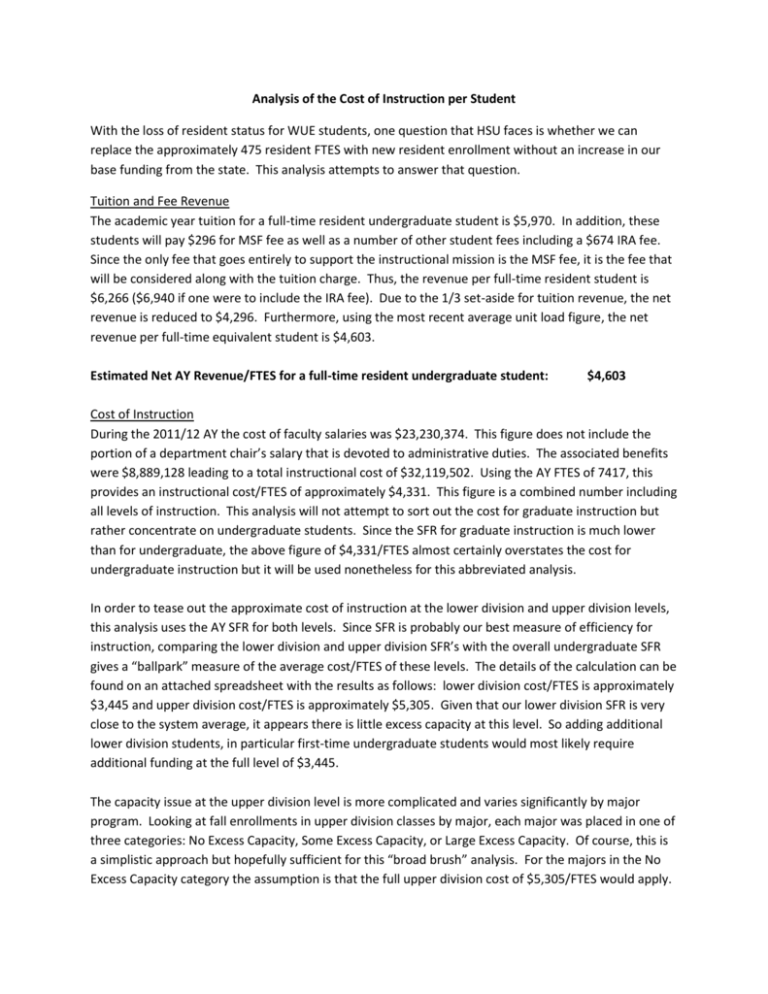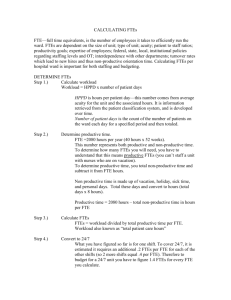Analysis of the Cost of Instruction per Student With the loss of
advertisement

Analysis of the Cost of Instruction per Student With the loss of resident status for WUE students, one question that HSU faces is whether we can replace the approximately 475 resident FTES with new resident enrollment without an increase in our base funding from the state. This analysis attempts to answer that question. Tuition and Fee Revenue The academic year tuition for a full-time resident undergraduate student is $5,970. In addition, these students will pay $296 for MSF fee as well as a number of other student fees including a $674 IRA fee. Since the only fee that goes entirely to support the instructional mission is the MSF fee, it is the fee that will be considered along with the tuition charge. Thus, the revenue per full-time resident student is $6,266 ($6,940 if one were to include the IRA fee). Due to the 1/3 set-aside for tuition revenue, the net revenue is reduced to $4,296. Furthermore, using the most recent average unit load figure, the net revenue per full-time equivalent student is $4,603. Estimated Net AY Revenue/FTES for a full-time resident undergraduate student: $4,603 Cost of Instruction During the 2011/12 AY the cost of faculty salaries was $23,230,374. This figure does not include the portion of a department chair’s salary that is devoted to administrative duties. The associated benefits were $8,889,128 leading to a total instructional cost of $32,119,502. Using the AY FTES of 7417, this provides an instructional cost/FTES of approximately $4,331. This figure is a combined number including all levels of instruction. This analysis will not attempt to sort out the cost for graduate instruction but rather concentrate on undergraduate students. Since the SFR for graduate instruction is much lower than for undergraduate, the above figure of $4,331/FTES almost certainly overstates the cost for undergraduate instruction but it will be used nonetheless for this abbreviated analysis. In order to tease out the approximate cost of instruction at the lower division and upper division levels, this analysis uses the AY SFR for both levels. Since SFR is probably our best measure of efficiency for instruction, comparing the lower division and upper division SFR’s with the overall undergraduate SFR gives a “ballpark” measure of the average cost/FTES of these levels. The details of the calculation can be found on an attached spreadsheet with the results as follows: lower division cost/FTES is approximately $3,445 and upper division cost/FTES is approximately $5,305. Given that our lower division SFR is very close to the system average, it appears there is little excess capacity at this level. So adding additional lower division students, in particular first-time undergraduate students would most likely require additional funding at the full level of $3,445. The capacity issue at the upper division level is more complicated and varies significantly by major program. Looking at fall enrollments in upper division classes by major, each major was placed in one of three categories: No Excess Capacity, Some Excess Capacity, or Large Excess Capacity. Of course, this is a simplistic approach but hopefully sufficient for this “broad brush” analysis. For the majors in the No Excess Capacity category the assumption is that the full upper division cost of $5,305/FTES would apply. In the middle category of Some Excess Capacity, the assumption is the 70% of the full cost would apply leading to a cost/FTES of $3,713. Finally, for the majors with Large Capacity available it is assumed there would be some additional instructional cost involved (primarily for UD GE) so the factor is 20% leading to a cost/FTES of $1,061. In order to get an average cost/FTES for upper division transfer students, the percentage of students majoring in the three types of programs described above was calculated using this year’s incoming upper division transfer cohort. If the average cost/FTES for upper division transfers is weighted by the percentage of the cohort that they represent then this leads to a weighted average cost of $3,263. If the mix of incoming transfer students were to change substantially then certainly the average cost would need to be adjusted. Summarizing the cost of instruction calculations described above leads to the following: Estimated Average AY Cost per FTES for a first-time undergraduate student: Estimated Average AY Cost per FTES for a new upper division transfer student: $3,445 $3,263 Comparing these two figures with the estimated revenue from above it appears that there should be sufficient revenue to cover the additional expense of adding these students if that revenue is applied for additional instructional costs. This analysis is for marginal increases in student enrollment only and cannot be extrapolated to large scale growth where additional resources would be required for many campus programs in addition to faculty salaries and benefits.










